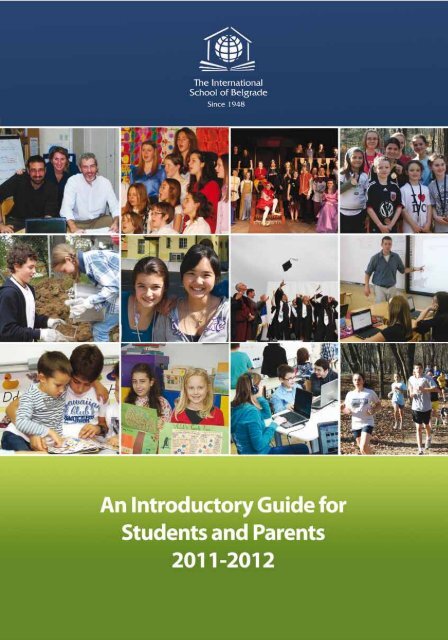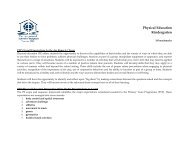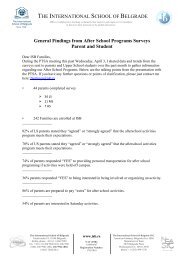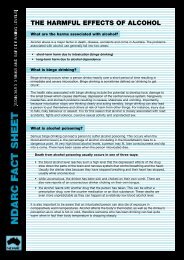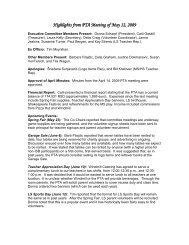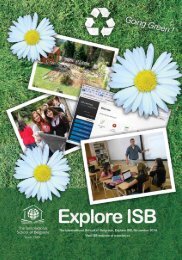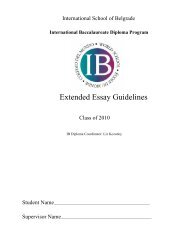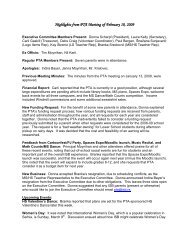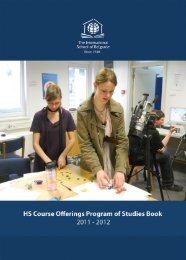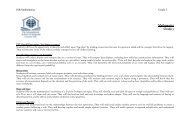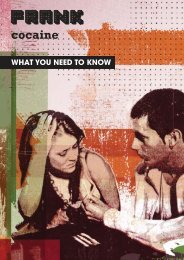Primary Years Program (PYP) - the International School of Belgrade
Primary Years Program (PYP) - the International School of Belgrade
Primary Years Program (PYP) - the International School of Belgrade
- No tags were found...
Create successful ePaper yourself
Turn your PDF publications into a flip-book with our unique Google optimized e-Paper software.
An Introductory Guide for Students and Parents 2011 -2012Table <strong>of</strong> ContentsISB Vision Statement 4Accreditation 5ISB Curriculum Model 6History 6<strong>Primary</strong> <strong>Years</strong> <strong>Program</strong> (<strong>PYP</strong>) 7Middle <strong>Years</strong> <strong>Program</strong> (MYP) 9Diploma <strong>Program</strong> (DP) 10Technology at ISB 11Special Needs 15Creativity, Action, Service (CAS) 16English as an Additional Language (EAL) 16Language B 17Fine Arts 19ISB Health Services 20Student Activities 20ISB Parent Teacher Student Association (PTSA) 22Statistics on ISB Faculty 23Admission 24Tuition Fees 2011 – 2012 <strong>School</strong> Year 25Application for Admission 27Parent / Guardian Information 28Medical Form 29Student Physical Examination Form 30<strong>School</strong> Calendar 2011 - 2012 31
An Introductory Guide for Students and Parents 2011 -2012ISB Curriculum Model<strong>International</strong> Baccalaureate Organization (IBO)IBO Mission StatementThe <strong>International</strong> Baccalaureate aims to develop inquiring,knowledgeable and caring young people who help to createa better and more peaceful world through interculturalunderstanding and respectThe IBO works with schools, governments and international organizations to develop challenging programs<strong>of</strong> international education and rigorous assessment. As an IB World <strong>School</strong>, ISB <strong>of</strong>fers all three programs:<strong>Primary</strong> <strong>Years</strong> <strong>Program</strong> (<strong>PYP</strong>), Middle <strong>Years</strong> <strong>Program</strong> (MYP) and Diploma <strong>Program</strong> (DP).These programs encourage students across <strong>the</strong> world to become active, compassionate and lifelonglearners who understand that o<strong>the</strong>r people, with <strong>the</strong>ir differences, can also be right.HistoryFounded in 1948 by <strong>the</strong> wife <strong>of</strong> <strong>the</strong> British Ambassador, Lady Peak, <strong>the</strong> Foreign Colony <strong>School</strong> was housedin two rented rooms at <strong>the</strong> American Mission. One staff member, assisted by mo<strong>the</strong>rs, taught elementarychildren using British texts. The wife <strong>of</strong> <strong>the</strong> American Ambassador became <strong>the</strong> first chairperson <strong>of</strong> <strong>the</strong><strong>School</strong> Board in 1949.During <strong>the</strong> 1950s, <strong>the</strong> <strong>School</strong> grew to be a K-8 school using American Forces’ teaching manuals. In 1952, <strong>the</strong>name was changed to <strong>the</strong> <strong>International</strong> <strong>School</strong> <strong>of</strong> <strong>Belgrade</strong>.In 1957, ISB moved to its present Lower <strong>School</strong> residential location. The Main Villa was remodeled andadditional buildings were constructed on <strong>the</strong> beautiful grounds. Enrollment has fluctuated considerably,reflecting <strong>the</strong> population <strong>of</strong> <strong>the</strong> diplomatic community, <strong>the</strong> establishment <strong>of</strong> o<strong>the</strong>r foreign national schoolsin <strong>Belgrade</strong>, and <strong>the</strong> political and economic situation in <strong>the</strong> former Yugoslavia.6
An Introductory Guide for Students and Parents 2011 -2012In 1962, <strong>the</strong> <strong>School</strong> began to receive yearly United States Government financial grants enabling <strong>the</strong>recruitment <strong>of</strong> overseas-hired teachers and <strong>the</strong> opportunity for long-term teachers to attend courses atU.S. universities. From 1966 through 2000, <strong>the</strong> <strong>School</strong> was associated with <strong>the</strong> Pittsford, New York <strong>School</strong>District in a <strong>School</strong>-to-<strong>School</strong> program, which included resources, information, and teacher exchange. ISBalso became associated with <strong>the</strong> European Council <strong>of</strong> <strong>International</strong> <strong>School</strong>s and <strong>the</strong> Central and EasternEuropean <strong>School</strong> Association.ISB was accredited in 1981 by <strong>the</strong> New England Association <strong>of</strong> <strong>School</strong>s and Colleges and <strong>the</strong> EuropeanCouncil <strong>of</strong> <strong>International</strong> <strong>School</strong>s.In <strong>the</strong> spring <strong>of</strong> 2003, ISB inaugurated <strong>the</strong> opening <strong>of</strong> <strong>the</strong> second campus for grades 6 through 12. To caterfor expanding student population, in <strong>the</strong> fall <strong>of</strong> 2005, <strong>the</strong> middle school was located on a newly renovatedthird campus within walking distance <strong>of</strong> <strong>the</strong> o<strong>the</strong>r two campuses.Thousands <strong>of</strong> children have passed through <strong>the</strong> ISB threshold <strong>of</strong> knowledge since its inception. The futurelooks bright, not only for <strong>the</strong> <strong>International</strong> <strong>School</strong> <strong>of</strong> <strong>Belgrade</strong>, but also for <strong>the</strong> country as a whole.<strong>Primary</strong> <strong>Years</strong> <strong>Program</strong> (<strong>PYP</strong>)The <strong>PYP</strong> is a transdisciplinary program <strong>of</strong> international education designed to foster <strong>the</strong> development <strong>of</strong><strong>the</strong> whole child. Designed for students from age 3 to 12, it focuses on <strong>the</strong> total growth <strong>of</strong> <strong>the</strong> developingchild, touching hearts as well as minds, and encompassing social, physical, emotional, and culturalneeds, in addition to academic development. Drawing from a wealth <strong>of</strong> knowledge and experience frominternational schools and focusing on research and best practice from a range <strong>of</strong> national systems, <strong>the</strong> <strong>PYP</strong>creates a relevant, engaging, challenging and significant educational framework for all children.The <strong>PYP</strong> Curriculum ModelTeachers and students are guided by six <strong>the</strong>mes as <strong>the</strong>y design curricular units for exploration and study.Students explore subject areas through <strong>the</strong>se <strong>the</strong>mes, <strong>of</strong>ten in ways that transcend conventional subjectboundaries. In <strong>the</strong> process, <strong>the</strong>y develop an understanding <strong>of</strong> important concepts, acquire essential skillsand knowledge, develop particular attitudes, and learn to take socially responsible action.The aim <strong>of</strong> <strong>the</strong> <strong>PYP</strong> program is to develop students who display <strong>the</strong> attributes <strong>of</strong> <strong>the</strong> learner pr<strong>of</strong>ile. IBlearners strive to be inquirers, knowledgeable, thinkers, communicators, principled, open-minded, caring,risk-takers, balanced and reflective.7
An Introductory Guide for Students and Parents 2011 -2012The <strong>PYP</strong> is made up <strong>of</strong> <strong>the</strong> following five essential elements: concepts, transdisciplinary skills, attitudesaction, and knowledge.ConceptsEight fundamental concepts, expressed as key questions, propel <strong>the</strong> process <strong>of</strong> inquiry and help toencourage a transdisciplinary perspective. These concepts drive <strong>the</strong> investigation and are called units <strong>of</strong>inquiry. These units are co-designed by teachers and students which are at <strong>the</strong> heart <strong>of</strong> <strong>the</strong> curriculummodel.The concepts are <strong>the</strong> following:Form:Function:Causation:Change:Connection:Perspective:Responsibility:Reflection:What is it like?How does it work?Why is it like it is?How is it changing?How is it connected to o<strong>the</strong>r things?What are <strong>the</strong> points <strong>of</strong> view?What is our responsibility?How do we know?Transdisciplinary SkillsFive categories <strong>of</strong> skills acquired in <strong>the</strong> process <strong>of</strong> structured inquiry are: thinking, communication, social,research and self - management skills. These skills are applied and practiced across <strong>the</strong> curriculum for avariety <strong>of</strong> purposes.AttitudesThe program promotes and fosters a set <strong>of</strong> attitudes that include tolerance, respect, integrity, independence,enthusiasm, empathy, curiosity, creativity, cooperation, confidence, commitment and appreciation.ActionStudents are encouraged to reflect, make informed choices, and take action that will impact <strong>the</strong>ir peers,school staff and <strong>the</strong> wider community.KnowledgeThe <strong>Primary</strong> <strong>Years</strong> <strong>Program</strong> identifies a body <strong>of</strong> significant knowledge relevant for all students in sixprincipal subject areas: language arts; social studies; ma<strong>the</strong>matics; science; <strong>the</strong> arts; and personal, socialand physical education.The aim <strong>of</strong> all IB programs is to develop internationally minded people who, recognizing <strong>the</strong>ir commonhumanity and shared guardianship <strong>of</strong> <strong>the</strong> planet, help to create a better and more peaceful world.8
An Introductory Guide for Students and Parents 2011 -2012Middle <strong>Years</strong> <strong>Program</strong> (MYP)The IB MYP <strong>of</strong>fered at ISB covers grades 6, 7 and 8 at <strong>the</strong> Middle <strong>School</strong>, and grades 9 and 10 at <strong>the</strong> High<strong>School</strong>. The IB MYP is <strong>the</strong> natural continuation after <strong>the</strong> IB <strong>Primary</strong> <strong>Years</strong> <strong>Program</strong>, and is an excellentpreparation for <strong>the</strong> IB Diploma <strong>Program</strong>.The curriculum taught within <strong>the</strong> MYP is a well balanced, student-centered, international curriculumwhich includes teaching <strong>of</strong> eight subject groups, makes valid connections in traditional subjects with<strong>the</strong> real world through <strong>the</strong> five Areas <strong>of</strong> Interaction, and focuses on <strong>the</strong> development <strong>of</strong> <strong>the</strong> IB LearnerPr<strong>of</strong>ile. The curriculum combines academic rigor with important skills and attitudes appropriate for <strong>the</strong>challenges <strong>of</strong> <strong>the</strong> 21st century through teaching various Approaches to Learning. The purpose <strong>of</strong> teaching<strong>the</strong>se important skills is to enable students to be metacognitive at <strong>the</strong> end <strong>of</strong> <strong>the</strong> final MYP year, and wellprepared for <strong>the</strong> DP Theory <strong>of</strong> Knowledge.The philosophy <strong>of</strong> <strong>the</strong> MYP encompasses three fundamental concepts:• Holistic Education• Communication• Intercultural AwarenessISB students display in <strong>the</strong>ir everyday school life <strong>the</strong> philosophy <strong>of</strong> <strong>the</strong> MYP and <strong>the</strong> attributes <strong>of</strong> <strong>the</strong>IB Learner Pr<strong>of</strong>ile. They create, produce, and actively participate in a variety <strong>of</strong> school activities: VisualArts, Dramatic Productions, Community Service, Athletics, Student Council, Knowledge Bowl, Speech &Debate, and Excursions. Interdisciplinary units such as Spaces allow students to analyze and syn<strong>the</strong>size <strong>the</strong>curriculum into performance based outcomes.9
An Introductory Guide for Students and Parents 2011 -2012Diploma <strong>Program</strong> (DP)The IBO describes <strong>the</strong> DP as a comprehensive and challenging pre-university course that demands <strong>the</strong>best from both motivated students and teachers.“… Typically, diploma holders are ready to debate real-world issues from an international perspective and toprovide leadership and support in <strong>the</strong> local and global community. They demonstrate a capacity for in-depthstudy while maintaining a broad perspective <strong>of</strong> <strong>the</strong> different subject areas. They are able to ask challengingquestions but also know how to research a topic and express <strong>the</strong>ir opinion. They have a strong sense <strong>of</strong> <strong>the</strong>irown culture and identity, as well as <strong>the</strong> ability to communicate in two or more languages with people who havea different perspective <strong>of</strong> <strong>the</strong> world.”The DP at The <strong>International</strong> <strong>School</strong> <strong>of</strong> <strong>Belgrade</strong>:Because ISB is an international school serving a varied, multicultural community <strong>of</strong> students and teachers,<strong>the</strong> school <strong>of</strong>fers <strong>the</strong> <strong>International</strong> Baccalaureate Diploma <strong>Program</strong> for all students in Grades 11 and 12. ISBhas been an authorized Diploma <strong>Program</strong> school since April, 2005.To become successful candidates for <strong>the</strong> full IB Diploma - recognized and valued by competitive universitiesworldwide - students must take six courses, three at <strong>the</strong> Higher Level and three at <strong>the</strong> Standard Level.Diploma <strong>Program</strong> courses are <strong>of</strong>fered in all six subject areas and take two years to complete. In May <strong>of</strong> <strong>the</strong>irsenior year, ISB students sit for IBO external examinations.10
An Introductory Guide for Students and Parents 2011 -2012Technology at ISBISB recognizes <strong>the</strong> importance <strong>of</strong> au<strong>the</strong>ntically integrating technology in our learning environments. Ourtechnology program aims to provide students and staff with <strong>the</strong> necessary skills to meaningfully incorporatetechnology in <strong>the</strong>ir endeavors. Information and communication technology, ra<strong>the</strong>r than being viewed as aseparate subject, is interwoven into all aspects <strong>of</strong> <strong>the</strong> K-12 curriculum. It is a part <strong>of</strong> many MYP and IB unitsand nearly every <strong>PYP</strong> unit. In addition to developing digital skills and habits for learning and teaching in <strong>the</strong>classroom, teachers can also sign-up for computer lab time based on <strong>the</strong> needs <strong>of</strong> <strong>the</strong>ir unit. ISB has an ITDirector, a K–12 Technology Integration Specialist, a full-time Web / Media Developer and an IT Technician.Lower <strong>School</strong>In <strong>the</strong> 2009/2010 academic year a laptop cart program has been introduced into grades 3 – 5. Each <strong>of</strong> <strong>the</strong>three grade levels has received a laptop cart with 18 Toshiba 13.3” laptops located in homeroom classrooms.In addition to this, <strong>the</strong> Lower <strong>School</strong> is piloting an interactive whiteboard program, in which Grades 4 and5 are equipped with ceiling mounted projectors and iBoards. The newly redesigned LS Library has growninto a Media Lab, which <strong>of</strong>fers 12 Desktop computers for student research. It also hosts a scanner andcolor laser printer. Classroom teachers each have a wireless laptop. The Lower <strong>School</strong> also has several LCDprojectors/ document cameras, a portable Smart Board, digital cameras, and HD digital camcorders forteacher and student use. Future plans may include <strong>the</strong> expansion <strong>of</strong> <strong>the</strong> laptop cart program to Grades 1and 2, additional interactive whiteboards, and projection capabilities within classrooms. The Lower <strong>School</strong>utilizes high-quality educational s<strong>of</strong>tware suitable for various learning needs which are increasingly fallingunder Web 2.0 banner.11
An Introductory Guide for Students and Parents 2011 -2012Parent support is <strong>of</strong>fered through individual meetings and workshops. Individual meetings may be informal;however, <strong>the</strong> counselor may arrange a Student Study Team (SST) to address a student’s difficulties on abroader level. Throughout <strong>the</strong> school year school-wide parent meetings or workshops could be <strong>of</strong>fered toaddress bullying, alcohol, sex education, adolescence, and general middle school concerns. Parents thathave specific concerns regarding <strong>the</strong>ir child may always reach <strong>the</strong> counselor to set up any <strong>of</strong> <strong>the</strong> abovemeetings.High <strong>School</strong> Counseling (Grades 9 - 12):Personal Counseling and Pastoral CarePersonal counseling: Students are always welcome to come to <strong>the</strong> counseling <strong>of</strong>fice to talk informally;occasionally meetings are set up on a regular basis if <strong>the</strong> need arises. These meetings are kept confidentialunless intent to harm self or o<strong>the</strong>rs is disclosed. If requested, parents and students can meet jointly in <strong>the</strong>counselor’s <strong>of</strong>fice for family counseling. Parents are encouraged to contact <strong>the</strong> counselor on behalf <strong>of</strong> <strong>the</strong>family or <strong>the</strong>ir child.Orientation: The Peer Helpers program consists <strong>of</strong> a group <strong>of</strong> academically and behaviorally reliablestudents who have received teacher endorsements to become mentors to incoming 9 th graders andtransfer students. They are trained to aid <strong>the</strong>se new students in finding support, building social networksand succeeding academically. Peer Helpers meet regularly with <strong>the</strong>ir assigned students at least once amonth and <strong>the</strong> Peer Helpers group also assembles once a month to review progress or problems under <strong>the</strong>guidance <strong>of</strong> <strong>the</strong> counselor.Advisory: The high school has an advisory program which meets periodically and follows curricula thatare adjusted by grade level. Homeroom teachers and <strong>the</strong> school counselor, school doctor and <strong>the</strong> IB DP/MYP and CAS coordinators all deliver lessons depending on <strong>the</strong> content being discussed. Examples <strong>of</strong>subjects addressed include: bullying and cyberbullying, learning styles and multiple intelligences, thirdculture issues, sexual education, substance abuse, goal setting, study skills, stress reduction and timemanagement, Personal Projects, Extended Essays, CPR workshops, and Resume Writing.Senior Days: Following <strong>the</strong> completion <strong>of</strong> IB and Final Exams, grade 12 students are required to attenda series <strong>of</strong> workshops that are designed to help <strong>the</strong>m with <strong>the</strong> transition to higher education. These arehosted by <strong>the</strong> counselor, invited guest speakers, school doctor and teachers, and cover a variety <strong>of</strong> subjects,which may include: culture shock, managing personal finances, sexual education for <strong>the</strong> near-adult, <strong>the</strong>transition from high school to university, substance abuse, body image, depression and anxiety, laundryand ironing 101, and graduation practices and arrangements.SST: The Student Study Team, coordinated by <strong>the</strong> counselor, meets when a student need has been identified.All teachers and administrators/coaches <strong>of</strong> <strong>the</strong> student are invited to participate in this team, which <strong>the</strong>naims to identify <strong>the</strong> scope <strong>of</strong> <strong>the</strong>se issues and seek solutions. A summary <strong>of</strong> <strong>the</strong> results <strong>of</strong> <strong>the</strong>se meetingsare <strong>of</strong>ten sent to parents ei<strong>the</strong>r after a conference with <strong>the</strong> principal and counselor or as an informativeaddendum to o<strong>the</strong>r communications.14
An Introductory Guide for Students and Parents 2011 -2012College & University CounselingThe counselor works with all levels <strong>of</strong> high school students during <strong>the</strong>ir time at ISB to prepare <strong>the</strong>m for<strong>the</strong> college and university search and application process. Students in grades 9 and 10 prepare for <strong>the</strong>university admissions process by doing <strong>the</strong>ir best in coursework, extra-curricular activities and communityservice. On <strong>the</strong> school website, <strong>the</strong> counselor posts and updates a list <strong>of</strong> summer opportunities around<strong>the</strong> world and a comprehensive university handbook. All grade 10 students take <strong>the</strong> PSAT, which servesas practice for university entrance exams. Grade 9 and 10 students are also given accounts on NavianceFamily Connection, <strong>the</strong> school’s university application s<strong>of</strong>tware, and shown how to search universitiesthat match <strong>the</strong>ir interests and needs. This foundation prepares <strong>the</strong>m for <strong>the</strong> formal university applicationprocess in grades 11 and 12. Grade 11 students are encouraged to take <strong>the</strong> PSAT again if <strong>the</strong>y intend toapply to a university that requires <strong>the</strong> SAT for admission, and have access to an SAT prep class that ISBaccommodates on school grounds. We serve as an SAT testing center and host examinations in October,November, December, May and June.The university admissions counseling process at ISB includes group and individual student meetings,parent c<strong>of</strong>fees, family meetings and scheduled university visits. Course selection at <strong>the</strong> end <strong>of</strong> grade 10includes a conversation about university goals. Several university representatives visit <strong>the</strong> high schoolcampus throughout <strong>the</strong> year and students at every grade level are invited to attend. Workshops on resumeand personal statement writing are <strong>of</strong>fered in grades 11 and 12, as are presentations on <strong>the</strong> applicationprocess as it varies by region, and an explanation <strong>of</strong> <strong>the</strong> steps that students should be taking at any givenpoint. Evening programs in <strong>the</strong> middle <strong>of</strong> grade 11 are followed by individualized student and/or familymeetings which outline a student’s goals for post-secondary study. In <strong>the</strong> beginning <strong>of</strong> grade 12, <strong>the</strong>formal application process begins in earnest. At this point, students are encouraged to have a reasonablelist <strong>of</strong> universities to which <strong>the</strong>y are applying.The goal <strong>of</strong> counseling students through <strong>the</strong> university admissions process is to help students realize whatpost-secondary options would best suit <strong>the</strong>ir needs and aspirations. To this end, <strong>the</strong> counselor worksclosely with families and students to research possible university options, develop a list <strong>of</strong> schools thatprovide a “match” for <strong>the</strong> students, and submit <strong>the</strong>ir applications in a thorough and timely fashion. MostISB students choose to attend university in <strong>the</strong> United States, Canada, <strong>the</strong> United Kingdom, Europe andAustralia. With <strong>the</strong> successful completion <strong>of</strong> <strong>the</strong> full IB Diploma at <strong>the</strong> end <strong>of</strong> grade 12, students improve<strong>the</strong>ir chance <strong>of</strong> admission to universities around <strong>the</strong> world.Special NeedsWhile staff and specialists provide support for learning differences, ISB does not have <strong>the</strong> resources orprograms to support students with major learning disabilities or physical challenges. A child with amoderate to severe disability is defined as a child who requires more than one period (45 minutes) <strong>of</strong>individual or small group assistance up to four times a week from a teacher in order to be successfulwithin <strong>the</strong> core academic program. Students manifesting mild disabilities are served in <strong>the</strong> mainstreameducational program and receive support services.15
An Introductory Guide for Students and Parents 2011 -2012Creativity, Action, Service (CAS)The Creativity, Action, Service (CAS) requirement is a fundamental part <strong>of</strong> <strong>the</strong> IB Diploma <strong>Program</strong> and ittakes seriously <strong>the</strong> importance <strong>of</strong> life outside <strong>the</strong> world <strong>of</strong> scholarship, providing a refreshing counterbalanceto academic studies. Through organizing, carrying out and reflecting on <strong>the</strong> CAS activities and field trips,students are being challenged to step out <strong>of</strong> <strong>the</strong>ir comfort zone in order to develop a spirit <strong>of</strong> openmindednessand discovery.Through balanced creativity, action and service activities, students are given a valuable opportunity tomeet local and international non-government organizations which open doors to students as <strong>the</strong>y develop<strong>the</strong>ir interests. Moreover, students learn how to take initiative, as <strong>the</strong>y become aware <strong>of</strong> <strong>the</strong> humanitarianissues across <strong>the</strong> world, waking in <strong>the</strong>m compassion and <strong>the</strong> gift <strong>of</strong> true giving.Simply put, our students become better informed citizens <strong>of</strong> <strong>the</strong> world. Some <strong>of</strong> <strong>the</strong> activities that take placethrough <strong>the</strong> CAS program are: Senjak Clean-Up, Drinka Orphanage Clo<strong>the</strong>s Drives, National DemocraticInstitute Internships, MS/HS Food Drive through Bread <strong>of</strong> Life organization, and <strong>the</strong> CAS Fair.English as an Additional Language (EAL)ISB embraces <strong>the</strong> IB concept <strong>of</strong> an international education that promotes intercultural understanding. Therich development <strong>of</strong> language and literacy for all learners is an essential element <strong>of</strong> all three IB programsat ISB.In order to enable all students in <strong>the</strong> school to access <strong>the</strong> curriculum in a manner that allows <strong>the</strong>m tobenefit fully from <strong>the</strong>ir education and to reach <strong>the</strong>ir full potential, ISB provides an English as an AdditionalLanguage (EAL) program for all students for whom English is not <strong>the</strong>ir native tongue. We believe thatlearning a second language is a developmental process that occurs over a number <strong>of</strong> years. Developingbasic interpersonal communication skills (BICS) can take up to two years while <strong>the</strong> more demandingcognitive academic language pr<strong>of</strong>iciency (CALP), <strong>the</strong> level <strong>of</strong> English language competence required tohave adequate access to <strong>the</strong> mainstream curriculum, can take up to seven years to fully develop. For thisreason ISB considers EAL to be a long-term commitment.16
An Introductory Guide for Students and Parents 2011 -2012benefit fully from <strong>the</strong>ir education and to reach <strong>the</strong>ir full potential, ISB provides an English as an AdditionalLanguage (EAL) program for all students for whom English is not <strong>the</strong>ir native tongue.ISB recognizes that learning a second language is a developmental process that occurs over time. ISBsupports <strong>the</strong> IB philosophy that when possible, pr<strong>of</strong>iciency in language should be <strong>the</strong> goal <strong>of</strong> secondlanguageacquisition, and will <strong>the</strong>refore encourage students to continue <strong>the</strong>ir studies in languages <strong>of</strong>previous tutelage and knowledge.ISB’s Language Policy Committee’s goal is to ensure this policy is supported and practiced by all ISB teachers.The committee will continue to evaluate <strong>the</strong> policy’s implementation and to ensure it meets <strong>the</strong> needs <strong>of</strong>ISB’s students.<strong>Primary</strong> <strong>Years</strong> <strong>Program</strong>From grades 1 to 5, students pr<strong>of</strong>icient in English opt for one <strong>of</strong> <strong>the</strong> following foreign languages: French,Serbian or Spanish. EAL teachers toge<strong>the</strong>r with classroom teachers determine when an EAL student isready to start learning a foreign language.Middle <strong>Years</strong> <strong>Program</strong>ISB <strong>of</strong>fers three foreign languages French FL (foundation, standard to advanced), Serbian FL (foundationto standard) in grades 6 to10, and from 2009/2010 ISB will <strong>of</strong>fer Spanish for those students who beganlearning Spanish in <strong>PYP</strong>.French students are prepared for Diploma in French Language Studies (DELF) examination every schoolyear, which is organized by <strong>the</strong> French cultural center in Serbia. This diploma is highly recognized in Europe.French students may continue French as a foreign language, (Language B) in DP.Diploma <strong>Program</strong>ISB <strong>of</strong>fers three foreign languages in <strong>the</strong> DP program: French Language B, Russian and Spanish ab initio.French is an ISB elective course, starting in 2009-2010 ISB will <strong>of</strong>fer French as an elective.In order to provide foreign language instruction, ISB hires part time teachers to deliver <strong>the</strong> languageprogram. These teachers are supported by <strong>the</strong> school through a ‘Languages O<strong>the</strong>r than English 6-12’Department Head, as well as <strong>the</strong> DP Coordinator.ISB introduced <strong>the</strong> Serbian Mo<strong>the</strong>r Tongue program in 2005, <strong>the</strong>reby recognizing <strong>the</strong> importance <strong>of</strong>maintaining and fur<strong>the</strong>r developing a child’s mo<strong>the</strong>r tongue while acquiring a second or third language. ISBcontends that a strong foundation in one’s mo<strong>the</strong>r tongue facilitates success in learning a second language.Serbian MT is strongly recommended as a language choice for all Serbian mo<strong>the</strong>r tongue students (grades1 through 10), and as <strong>the</strong> group 1 course selection in grades 11 and 12.18
An Introductory Guide for Students and Parents 2011 -2012Fine ArtsFine Arts at ISB is an integral component <strong>of</strong> our curricular and co-curricular programs. Students gainvaluable experiences in music, drama, and visual arts in all grades. Students are given opportunities towork with artists from a variety <strong>of</strong> cultures, while actively creating and reflecting on <strong>the</strong>ir own work and <strong>the</strong>work <strong>of</strong> o<strong>the</strong>rs.The music program follows <strong>the</strong> strands <strong>of</strong> performance, composition, improvisation, listening, movement,and creativity. Students are engaged in <strong>the</strong>atre productions and curricular drama classes, thus enablingstudents to hone <strong>the</strong>ir communication and performance skills.Through various art techniques, materials, and <strong>the</strong> study <strong>of</strong> art history, students develop skills to createart work with confidence and ease while gaining a greater appreciation <strong>of</strong> Visual Arts. Student work isdisplayed in local galleries, school exhibits, and in CEESA Art Festivals throughout Europe. The Visual Artsinterdisciplinary units <strong>of</strong>ten include costuming and set design for school productions. Exhibitions, concerts,<strong>the</strong>atre productions, and in-class performances provide multiple outlets <strong>of</strong> artistic expression through <strong>the</strong>Fine Arts program at ISB.19
An Introductory Guide for Students and Parents 2011 -2012ISB Health ServicesISB considers <strong>the</strong> health and safety <strong>of</strong> its students and faculty <strong>of</strong> vital importance. The school has a fulltime,fully accredited <strong>School</strong> Physician on staff. Multiple staff members are trained in basic first aid, CPR,and defibrillation.All three campuses are well equipped with a proper medical room. The <strong>School</strong> Physician provides animmediate diagnosis and follows up with timely communication between school and home. Healthissues are addressed via letters, articles on <strong>the</strong> website, and direct telephone contact with parents. Annualmedical physical screenings are conducted at <strong>the</strong> beginning <strong>of</strong> <strong>the</strong> school year at all three campuses andperiodically throughout all grade levels when needed.The health <strong>of</strong>fice working hours are 8:00 am - 4:00 pm.Student ActivitiesCentral and Eastern European <strong>School</strong>s Association (CEESA)The <strong>International</strong> <strong>School</strong> <strong>of</strong> <strong>Belgrade</strong> is an active member <strong>of</strong> <strong>the</strong> Central and Eastern European <strong>School</strong>sAssociation (CEESA). CEESA sponsors a wide variety <strong>of</strong> activities. The list <strong>of</strong> activities in which ISBparticipates includes:High <strong>School</strong>BasketballSoccerVolleyballKnowledge BowlMath CompetitionSpeech & DebateChoral FestivalHands on Student InvolvementMiddle <strong>School</strong>BasketballSoccerVolleyballKnowledge BowlMath CountsSpeech & DebateCultural Arts FestivalChoral Festival20
An Introductory Guide for Students and Parents 2011 -2012After <strong>School</strong> Activities (ASA)Lower <strong>School</strong>Activities created in <strong>the</strong> Lower <strong>School</strong> ASA program consist <strong>of</strong>:CapoeiraComic Book ProductionCreative Movement & DanceExpressive DramaGirl’s and Boys’ SoccerKarateMagic TricksRhythmic GymnasticsBasketballArts & CraftsBadmintonForum TheaterIntroduction to SportsInteresting ScienceBall GamesStory Telling & Drama<strong>School</strong> NewsDrawing & PaintingIntro to Martial ArtsTreasure HuntLearn Your Favorite SongCeramic ArtMiddle <strong>School</strong> and High <strong>School</strong>High <strong>School</strong> and Middle <strong>School</strong> students may elect to participate in a variety <strong>of</strong> non – CEESA relatedactivities which change depending on student interest. Recent <strong>of</strong>ferings include:GardeningYearbookAmazing ArtOpen Studio (open only to IB)Cross Country RunningPeer HelpersGirls on <strong>the</strong> MovePhotographyFrench Language Club*German Mo<strong>the</strong>r Tongue*Spanish Language Club*Computer CornerSAT preparationLacrosseJazz & Blues BandPerforming Arts:HS Choir, HS CEESA Choir, Full Length Productions, One Act Plays, 24Hour Theatre, Thespian Society, Improv. Night, Scenes Night*Extra Fee Applicable21
An Introductory Guide for Students and Parents 2011 -2012ISB Parent Teacher Student Association (PTSA)The ISB PTSA arranges special events and activities to supplement <strong>the</strong> academic program and enhance <strong>the</strong>school’s sense <strong>of</strong> community, and serves as a liaison to encourage and facilitate communication betweenISB families, administration, and staff. Through a variety <strong>of</strong> fundraisers during <strong>the</strong> school year, such as <strong>the</strong>Book Fair, Garage Sale, Bingo Nights and Spring Fair, <strong>the</strong> PTSA organizes and finances many events for <strong>the</strong>ISB community. The PTSA uses funding from <strong>the</strong>se events to purchase athletic uniforms, musical equipment,and o<strong>the</strong>r material resources.PTSA Sponsored Events:• PTSA Wine and Cheese night and PTA Elections• Halloween & Harvest Festival• PTSA-SRC (Student Representative Council)• Book Fair Welcome Back Party• PTSA Easter Egg Hunt• PTSA Garage Sale• PTSA Spring Fair• PTSA Bingo Nights• PTSA Christmas Market and Santa visit• Parent Information Sessions/Evenings• Refreshments at HS Theatrical performancesAlthough <strong>the</strong> PTSA is managed by an Executive Committee consisting <strong>of</strong> four parent representatives from<strong>the</strong> Lower <strong>School</strong>, four parent representatives from <strong>the</strong> Middle/High <strong>School</strong>, and two teacher representatives(one from <strong>the</strong> Lower <strong>School</strong> and one from <strong>the</strong> Middle/High <strong>School</strong>), <strong>the</strong> real work behind <strong>the</strong> great PTSAsponsoredevents and programs is done by many dedicated parent , student and teacher volunteers.The PTSA works hard to bring <strong>the</strong> Parents, Teachers and Students <strong>of</strong> ISB toge<strong>the</strong>r and to foster a positivesense <strong>of</strong> community. The PTSA also works closely with <strong>the</strong> High <strong>School</strong> IB Diploma students and <strong>of</strong>fers<strong>the</strong>m <strong>the</strong> unique opportunity to become members <strong>of</strong> <strong>the</strong> PTSA volunteer team to earn community servicehours.22
An Introductory Guide for Students and Parents 2011 -2012Statistics on ISB FacultyOverall Faculty DistributionLocal Hire60%Foreign Hire40%Lower <strong>School</strong> Faculty DistributionLocal Hire66%Foreign Hire34%Secondary Education Faculty DistributionLocal Hire55%Foreign Hire45%23
An Introductory Guide for Students and Parents 2011 -2012AdmissionThe ISB seeks to admit students <strong>of</strong> expatriate families living in <strong>Belgrade</strong>, and Serbian students desiring aninternational education. Students who enroll at ISB are in agreement with <strong>the</strong> school vision and mission,and are capable <strong>of</strong> benefitting from <strong>the</strong> types <strong>of</strong> programs <strong>of</strong>fered.Students wishing to apply for admission to ISB can gain information about <strong>the</strong> school and its programs via<strong>the</strong> school’s website and/or through email and telephone contact with our Admissions Coordinator. Whenrequested, a pre-admissions meeting and school tour with our Admissions Coordinator can be arranged.Students may be considered for enrollment at ISB only after <strong>the</strong>ir application is complete. The perforatedpages at <strong>the</strong> back <strong>of</strong> this brochure are provided to help ensure that all necessary forms and transcriptsare received by ISB in a timely manner. An <strong>of</strong>ficial determination <strong>of</strong> admission will be made after all <strong>the</strong>documents mentioned below have been received:24
An Introductory Guide for Students and Parents 2011 -2012• A completed Application for Admission and <strong>the</strong> Parent/Guardian Information Form from <strong>the</strong>application packet (one form per student).• <strong>School</strong> records, <strong>of</strong>ficially translated into English, and <strong>of</strong>ficial transcripts from previous schools, for<strong>the</strong> past three academic years (both <strong>the</strong> original and a copy <strong>of</strong>ficially translated into English, if inano<strong>the</strong>r language).• A letter <strong>of</strong> recommendation from a current teacher (grades 1-12)• EAL/Language History Form (for non-native English speakers)• Photocopy <strong>of</strong> <strong>the</strong> student’s Birth Certificate or Passport• Physical Examination Form with doctor’s signature and stamp• Insurance/Acknowledgement <strong>of</strong> Risk Form• Financial Responsibility Declaration• One photograph <strong>of</strong> applicant (passport size)• Student Reference Form (K- grade 12)• World Language Questionnaire (Grades 1-12)• Growth and Development Form (Grades EY- grade 5)• Math Teacher Recommendation Form (Grades 6-12)The completed file is reviewed by <strong>the</strong> school. If <strong>the</strong> school has additional questions or concerns about astudent, <strong>the</strong> family will be contacted to provide additional information and/or denied admission. In suchcases, a review team will be formed with appropriate personnel, which may include <strong>the</strong> divisional principal,counselor, and teacher(s). DP students in grades 11 and 12 meet with <strong>the</strong> Diploma Coordinator.The non-refundable registration fee for <strong>the</strong> admitted student must be paid. Once <strong>the</strong> student is in <strong>Belgrade</strong>,a placement examination is administered. It takes between three and five school days from <strong>the</strong> completion<strong>of</strong> placement examination until a student matriculates.Tuition Fees 2011 – 2012 <strong>School</strong> Year1. Registration Fee – USD 875.00• One time only• Non-refundable2. Tuition and Fees Payment ScheduleTuition and fees shall be received by <strong>the</strong> Business Office by August 1 for <strong>the</strong> upcoming school year. If astudent’s enrollment date is after August 1 for <strong>the</strong> upcoming school year, all payments shall be received by<strong>the</strong> Business Office three weeks from <strong>the</strong> date <strong>of</strong> an invoice.Tuition and Fees are payable in currencies as noted in <strong>the</strong> Tuition and Fees Schedule, or in Dinars (RSD).25
An Introductory Guide for Students and Parents 2011 -2012Tuition Schedule (United States Dollars)GradeTuition Fee (USD)Pre-Kindergarten 12,965.00Kindergarten - Grade 5 18,480.00Grade 6 - Grade 8 19,990.00Grade 9 - Grade 12 22,285.003. Capital FeeThe Capital Fee is used to cover <strong>the</strong> cost <strong>of</strong> current and future facilities. This fee must be paid by August 1 for<strong>the</strong> upcoming school year. If a student’s enrollment date is after August 1 for <strong>the</strong> upcoming school year, <strong>the</strong>Capital Fee is due three weeks from <strong>the</strong> date <strong>of</strong> <strong>the</strong> invoice. Students attending school less than a full yearpay <strong>the</strong> entire fee. The Capital Fee assessed for <strong>the</strong> 2011 - 2012 school year is EUR 1,750.00 across all grades.THE CAPITAL FEE IS NON-REFUNDABLE AND IT IS NOT PRO-RATED ACCORDING TO ATTENDANCE.4. Late Payment <strong>of</strong> Tuition1 % penalty per month is applied to overdue paymentsStudents whose tuition is not paid in a timely manner may be suspended from attending <strong>the</strong> school at <strong>the</strong>discretion <strong>of</strong> <strong>the</strong> Director.5. Partial Year TuitionStudents attending school less than a full year pay <strong>the</strong> tuition based on <strong>the</strong> school’s four QUARTERS as follows:First Quarter August 22, 2011 - October 13, 2011Second Quarter October 19, 2011 - December 16, 2011Third Quarter January 9, 2012 - March 23, 2012Fourth Quarter March 26, 2012 - June 14, 2012The Director may authorize <strong>the</strong> refund <strong>of</strong> a student’s tuition for any full school calendar quarter <strong>of</strong> nonattendance,upon written request by <strong>the</strong> parent or guardian. New enrollees who begin school more than 15days into a given quarter will be charged tuition for <strong>the</strong> remaining quarter on a daily prorated basis.6. Installment PlanThe <strong>School</strong> <strong>of</strong>fers an installment plan to parents who are individual tuition payers. A service fee <strong>of</strong> 4% ischarged for using this payment plan. If you wish to discuss an installment payment plan, please contact <strong>the</strong>Business Office at +381-11-206-9919.26
Application for Admission for Admission
Parent / Guardian Information
Medical FormMedical FormPlease provide prior to enrollment:Completed ISB medical formPhysical examination performed by a physicianTuberculosis skin testCompleted immunizations for: dip<strong>the</strong>ria, tetanus, polio, measles, mumps, and rubella (according to age)Hearing test and vision examinationPhysician’s summary and recommendations, DATED WITHIN 6 MONTHS OF ENROLLMENT. For children withchronic or recurring conditions, such as allergies, asthma, diabetes, attention deficit disorder etc., includeany limitations or precautions and medications which may be needed at school.Please note that <strong>the</strong> above information must be submitted BEFORE your children starts school.
Student Physical Examination FormStudent Physical Examination Form
<strong>School</strong> Calendar 2011 - 2012
E-mail: admissions@isb.rsWeb: http://www.isb.rs


